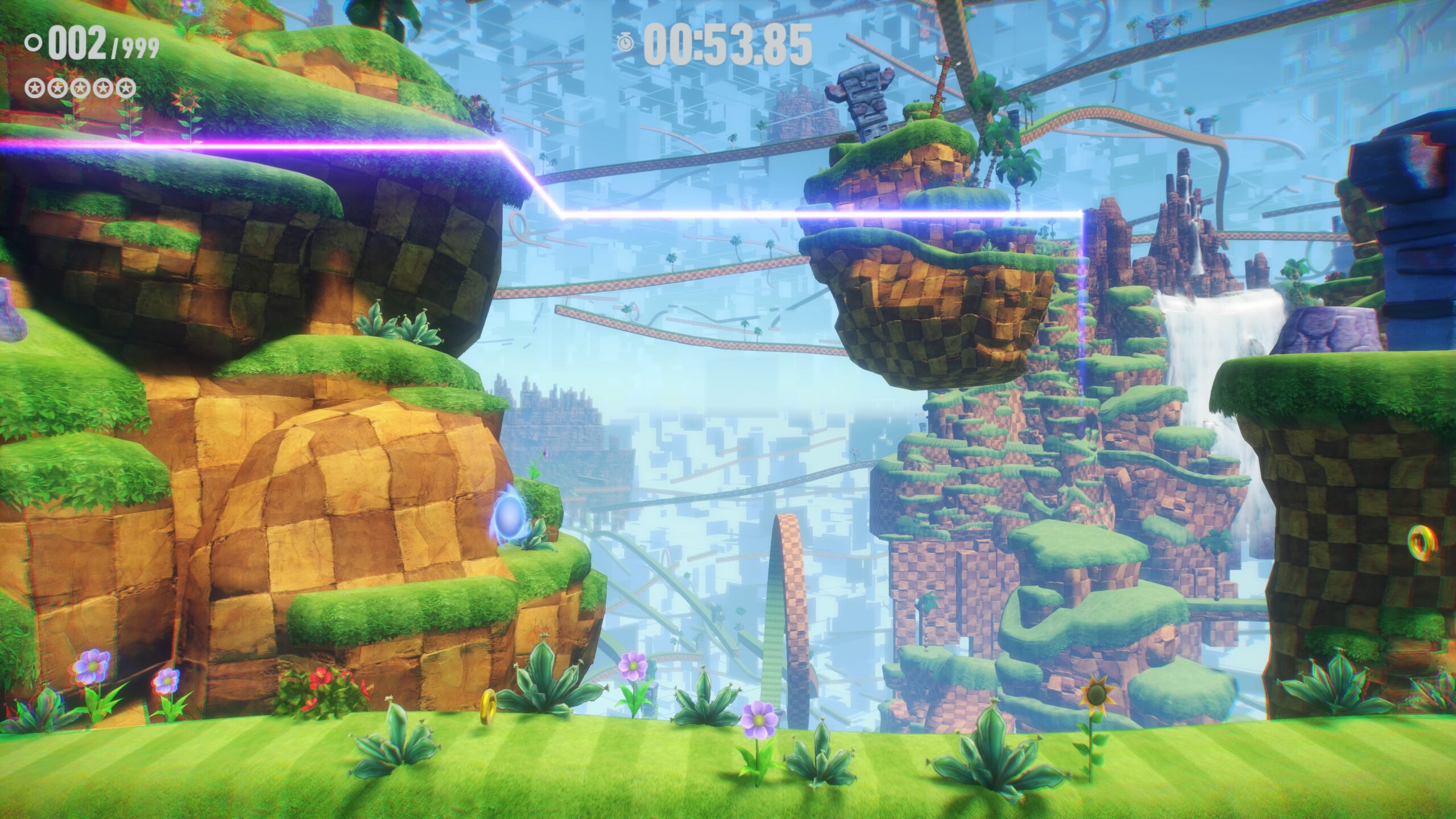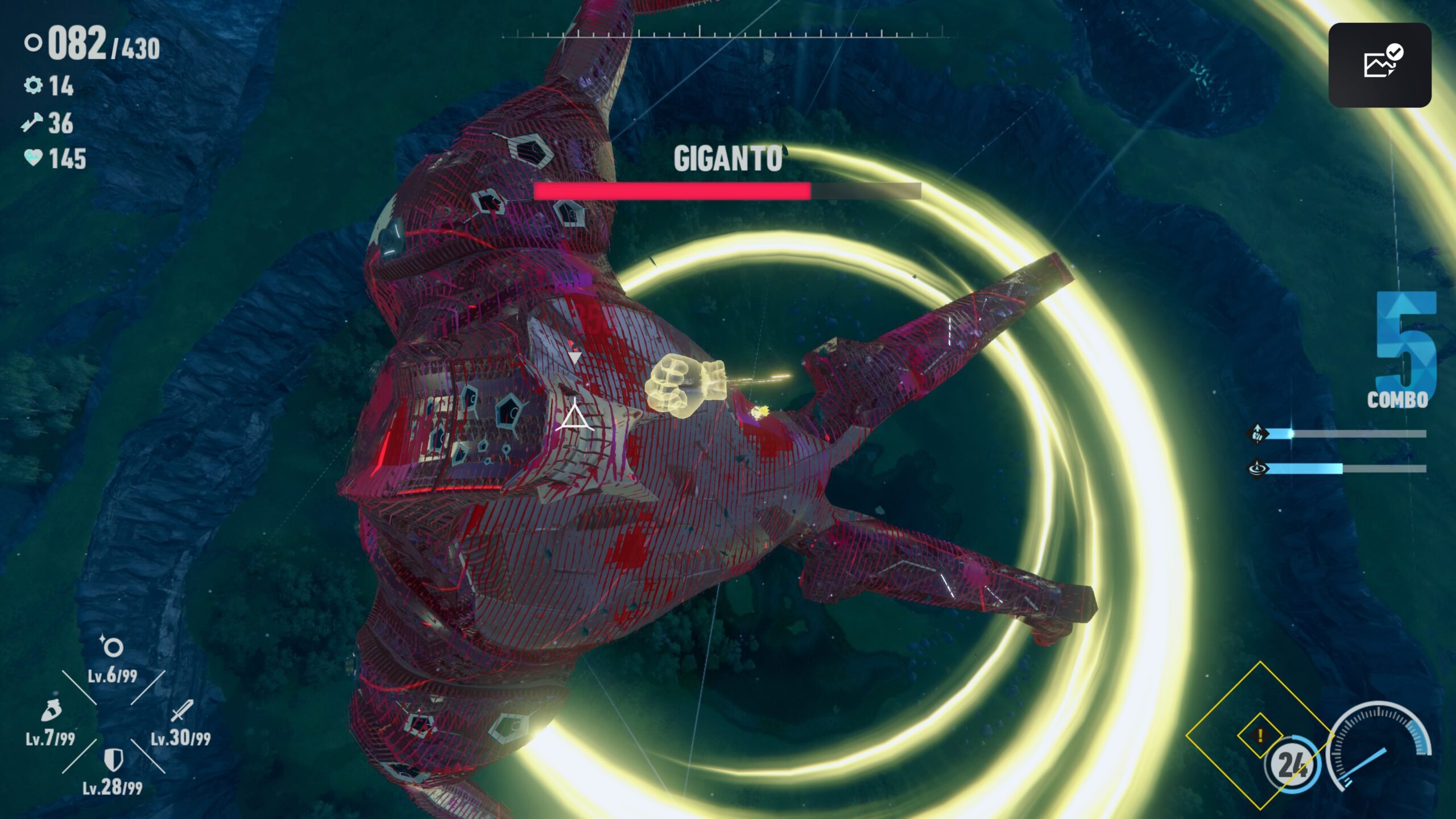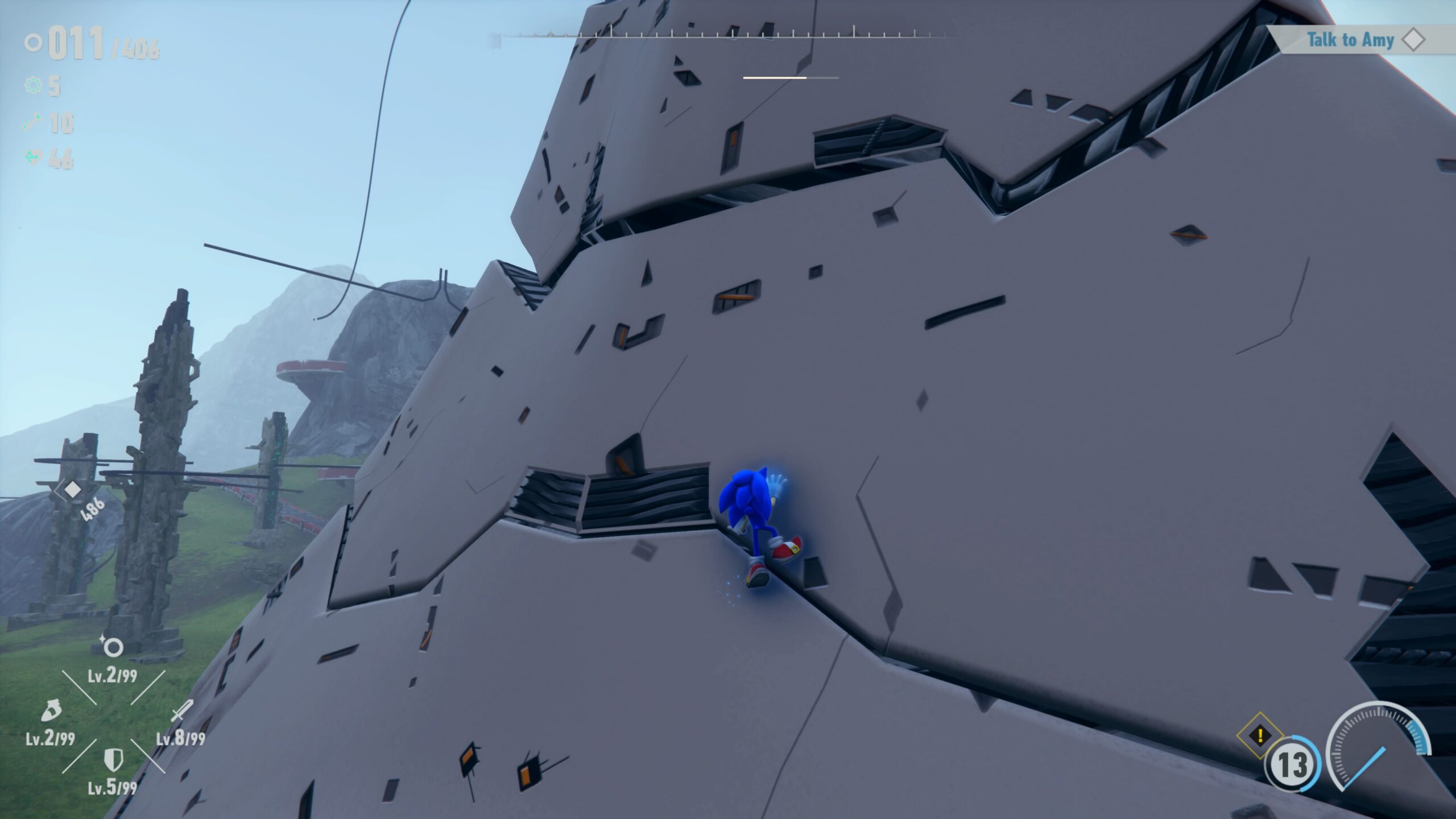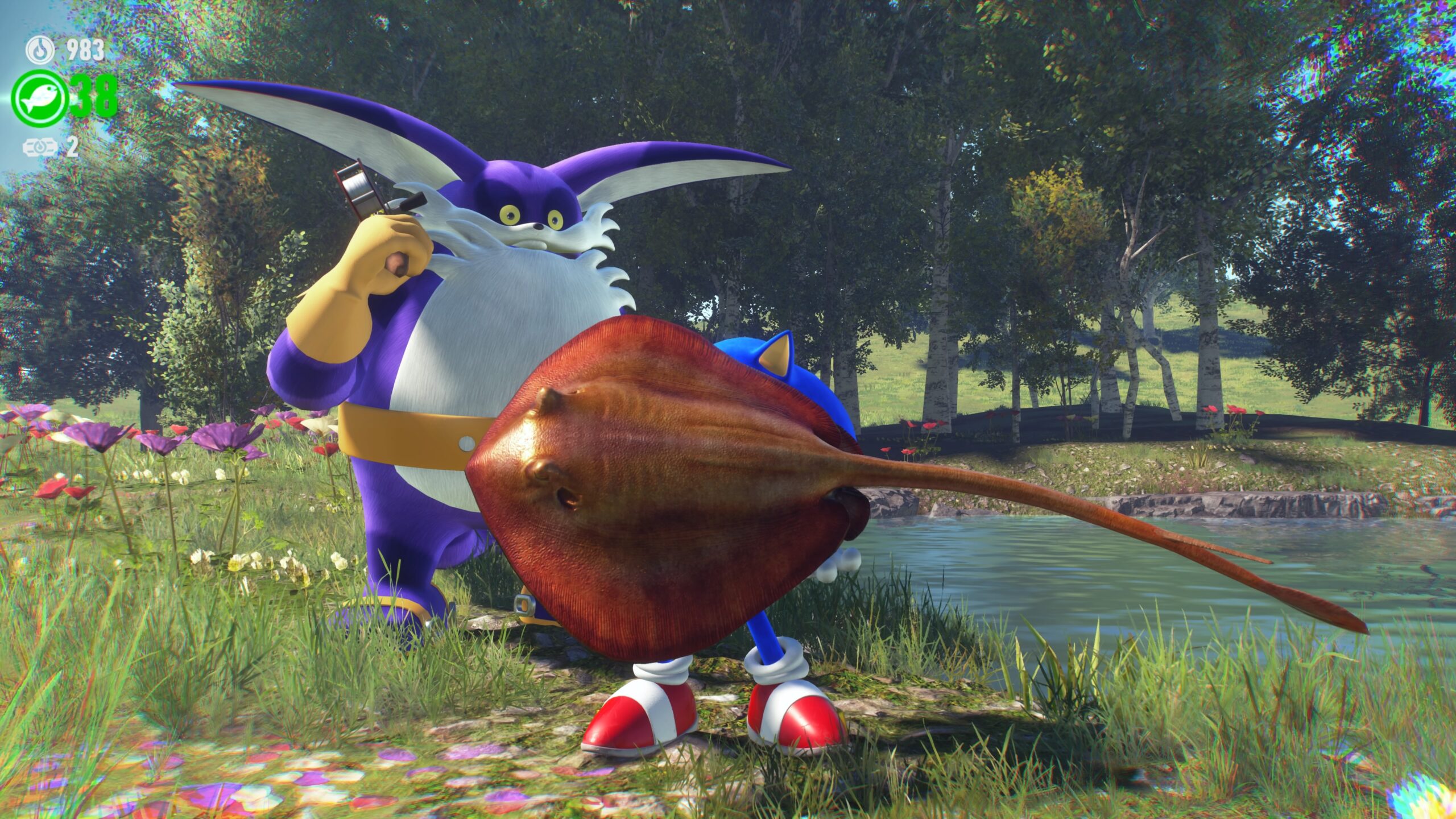REVIEW: Sonic Frontiers (2022)
Gotta Go Explore, Then Go Fast
Sega’s blue answer to Mario has had a whirlwind of ups and downs since debuting in 1991 on the Sega Genesis. The snarky hedgehog has been featured in some of the worst platforming games of all time, like Sonic ’06, and has also been the star of some fun and impressive gems, such as Sonic CD and the recent Sonic Mania. It’s no surprise that the gaming world was eagerly anticipating the new open-world Sonic game slated for 2022. I was eager to play it for the trainwreck it could be or the initial promise of a new, high standard for 3D Sonic. Thankfully, it’s the second that ended up being true as I continued grinning like a 90s child discovering Sonic for the first time while playing Sonic Frontiers.
Sonic Frontiers does so much right with the 3D open-world platforming framework. World traversal is not only quick and convenient but fun and exciting. The world is littered with obstacles for the blue hedgehog to tackle, yet the many rails, loops, and platforms are intelligently placed to guide the player to the next attraction. The traditional platforming stages are well-crafted and offer something for players who don’t want the open-world experience too. The aspect of Sonic Frontiers that I’m not impressed by is its story. Super fans will no doubt love aspects of the story, but casual players probably won’t find it all that interesting. It’s not terrible, but the story and characters didn’t “wow” me as much as the rest of the game. Going back to Sonic’s debut in 1991, the story wasn’t the focus: the exhilarating gameplay and unique platforming wee, so that’s where we’ll start in this review.
Game Feel and Movement

Sonic is nothing without decent movement controls, so it’s a relief that Frontiers delivers an optimal movement scheme for the blue hedgehog in a fast-paced 3D environment. The player is given full camera movement in the open-world sections, only being limited by various 2D sidescrolling sections where the camera locks to a classic and tight old-school perspective. The camera shifts aren’t that jarring, but it might take a while to get used to for new players. A problem I’ve had with several 3D Sonic games that isn’t present here is Sonic accelerating too fast to keep up with and control properly. I always feel in control of the speed in Sonic Frontiers, even with near-fully upgraded speed stats where I was sprinting across the map at a ridiculous pace. Part of the reason Sonic is easy to control is that obstacles in the open world are spaced out, so the player isn’t too overwhelmed. Jumping is precise enough for a platformer that isn’t that reliant on precision, and the turning is just right for what you’re doing in the game. The 180-degree turning radius isn’t that sharp for a platformer, so you’ll find yourself doing a wide arc and missing your path on several occasions, but again, the game’s objectives don’t require quick turns often enough for it to be too much of a nuisance. What you will be using these slick controls for is quite fun and varied.
Speeding through the Open World

The open world consists of various collectibles that open gates to traditional stages, progress the story, and upgrade Sonic’s abilities and stats. Any screenshot of Sonic Frontiers’ open world will likely show an assortment of confusing loops, rails, speed tiles, ramps, and the like that make one think of an amusement park; these are the ways to obtain collectibles required for progression. Collectathon lovers rejoice; there’s a lot to love here for us. I can’t tell you how much time I spent doing many of these virtual jungle gym attractions; they’re just so fun and engaging in the way they tap into the classic Sonic formula of extreme platforming and speed. The arsenal of platforming tricks used for the various obstacles ranges from timed directional cannons (like DKC barrels) to target-warping across trails of balloons to climbing and looping your way up a colossal tower of platforms in the sky. Many of these attractions can be skipped if you have obtained enough keys or hearts to progress, yet the collectathon gamer can spend dozens of hours going through these sets of obstacles littered across the large map.

Additionally, sections of the map become uncovered when solving challenges on each island. These map challenges range from sprinting to a location before the time runs out, traditional puzzles aligning mirrors for light to hit a target (think Zelda), or filling out squares on a board in the right order. I much prefer solving a puzzle or quick challenge to unlock more of the map rather than the typical open-world design of climbing a lookout tower or clearing bad guys out of an area, so I really enjoyed the way Frontiers does map unlocking with fun puzzles and acrobatics. Related to the excellent movement in this game, these challenges unlock a rail that connects the previous challenge spot to your current location. The cool thing is that doing all the challenge spots on an island unlocks a connected rail system spanning the entire map, enabling lightning-fast movement across the island. But the rail network isn’t the only convenient way to travel the map because there’s also traditional fast travel between portals (traditional stages), which unlocks after opening every portal. Spending time exploring the open world for all these collectibles and unlocks wouldn’t be nearly as enjoyable if not for the beautiful music strewn throughout the game. The first island has six or so arrangements of that island’s theme that updates as you progress through the story, and it is phenomenally composed and produced. Just listen to the 4th movement of the first island’s theme; it’s gorgeous…
Art direction and graphics go a long way toward making exploration fun as well. Sega used the same engine as their beautiful Phantasy Star Online 2, and the results are impressive. Colors are especially dazzling, and the art direction is inspired and interesting. The strong graphical content doesn’t impede the performance of the game, either. I played Sonic Frontiers on PS5 and noticed little to no framerate issues, though there is some pop-in when going fast across the open world. The traversal across the open world is simply exceptional from both a micro and macro level, and I can’t help but applaud the Sonic team for nailing that pivotal aspect of flow so inherent in the series on a larger scale.
Traditional Stages

I’m glad Sonic’s stats don’t carry over into the classic stages since it could ruin the pitch-perfect pacing and flow of these well-crafted homages. There are about seven stages per island, and they have grades that grant the player chaos emerald vault keys for completing. What I love most about Sonic Frontiers’ stages is how refined and well-paced they are. Each stage has multiple routes, from subterranean tunnels to precarious platforms spread out across the clouds. You’ll rarely go through one stage the same way, which is a hallmark of classic Sonic design dating back even before Sonic Adventure on the Dreamcast (the game Frontiers is perhaps most inspired by). Some stages are brief affairs that take a spin on the sidescrolling formula like skateboarding; others are longer complex stages where the lines between the different routes become blurred, and memorization is more difficult. The music is different for each stage and synced to match the tempo Sonic’s routes take him. I often found myself flying off huge ramps synced perfectly to a crescendo in the song, and what’s impressive is that the songs aren’t automatically synced to stage progress, since retrying the stage continues at the place in the song where you left it. Songs are just built from the ground up with the stages in mind. I love each and every stage in this game, from the 2D stages to the overhead 3D ones; they’re fun, old-school, and flow well. Sure, the stages don’t reach the heights of Sonic’s best 2D games, but they are above average in the 3D department.
Enemies and Bosses
Another core aspect of progression throughout Sonic Frontiers is boss fights. The bosses spread across the world map each give gears, which are required to open each of the stages. The variety of bosses is pretty good, but you will fight the same bosses more than once throughout the game. Thankfully, most of these fights are interesting and fun, which is greatly helped by the convenient controls. The lock-on is snappy and intuitive, and setting up combos is a breeze and quite addicting. The bosses that require rail platforming to reach the hit spot are probably my favorites because they bring a bit of puzzle/platforming into the mix, along with traditional combat. The pure combat boss fights can be cheesed if the player levels up their power and health stats, but if Sonic is under-leveled, there’re plenty of ways to gain the upper hand, such as using combos effectively and parrying (which is not timed!). The combat is pretty straightforward, and the game gives you tutorials to try them in isolation. The bosses I don’t like quite as much are the flying ones. These bosses leave a trail of rails for Sonic to grind to catch up to them, which can be fun but annoying and long. Early in the game, your speed won’t be leveled up to the point where these fights can be done quickly, and they can go for a long time because of how slow Sonic catches up to the flyers. Getting hit on a rail is the worst when fighting these flyers, since the blow will send Sonic falling to the world below and require the fight to start over or the player to wait/catch up again. Checkpointing is also awful with these flying boss fights, and most boss fights in general, and that’s because there’s usually NO checkpoint at all. You start at the very beginning of the fight if you fail or fall off a rail, as I’ve done several times. Poor checkpointing aside, the flying bosses become a pushover once you level up speed and power a decent amount.

The real boss fights in Sonic Frontiers are the four titans across the islands. These big bads are spectacles that need to be experienced by every Sonic fan. The titan fights in Sonic Frontiers are like Dragon Ball Z Super Saiyan battles, and I absolutely adore it. Past games featured Super Sonic going nuclear on enemies, but this one takes it to another level with over-the-top metal music on top of crazy fights in the clouds involving Shadow of the Colossus-style platforming and beat-em-up antics. These titan fights are all very fun and engaging in a campy anime kind of way that most Sonic fans and gamers in general will unironically love.
Scaling Towers

Speaking of Shadow of the Colossus, there are some cool tower-scaling sections in Sonic Frontiers that surprised me. Various towers are spread across the islands, housing the chaos emeralds high above. Reaching them and scaling their heights remains one of the high points of the game for me, pun intended, and channels parts of Shadow of the Colossus and Assassin’s Creed. Imagine the best elements of those games, but with Sonic ingredients like rails, speed boosts, and crazy loops, and that’s what these map-revealing tower climbs are. One of my favorite parts of the game was an island almost exclusively devoted to these towers. Each was a marathon obstacle course to the top and perhaps the most fun I’ve had in the entire game. The flow from loop to loop, wall running through boost zones, and targeting balloons up the side of the tower are exhilarating and engaging all the way through.
Mandatory Minigames

But enough about having fun; Sonic Frontiers also features a smattering of minigames spread through the main story. These minigames are mandatory to proceed and are usually pretty annoying to get through since they often have nothing to do with Sonic’s arsenal of speed and acrobatics. My least favorite minigame is the timed Koco herding game. Koco are the only inhabitants of the islands Sonic and friends encounter, and you’ll find yourself herding them toward Amy or Knuckles with a failure state of them exploding on Sonic and forcing you to start the minigame over again. The time limit for the first herding game isn’t generous, to say the least, and the Koco don’t like to stay in a straight line. Sonic is also a tad too fast without the turning radius to accommodate a stray Koco on the side. It’s good there are only a couple of these herding minigames because they’re not fun. There’s also a pinball minigame in the 2nd half that requires a silly amount of perfection or luck to pass. I love Sonic Spinball, and even I was frustrated at the number of retries I succumbed to just to proceed through the story. There is at least one redeeming minigame, though, and that’s the wonderful bullet hell sequences. The classic color-coordinated projectiles as you shoot your way through waves of ships to a boss at the end are just plain fun and never overtuned like the other minigames.
Interrupting Flow
Since we dipped into some negative aspects of Sonic Frontiers, now’s a good time to mention my absolute least favorite part of the overworld. Enemies and bosses reset on the world map every time a Starfall event occurs. These occurrences are infrequent to a degree but happened to me at least three times per island, which means I’d often just finish defeating a boss only to have a Starfall happen and that same boss reappear in front of me seconds later. Enemy resets are a good idea when spaced out between long periods of time or when they’re optional, but I’ve had to mow through the same bosses as I’m exploring the map for collectibles or leisure far too often. Perhaps the worst aspect of Starfall, though, is the slot machine stuck to the center-top of the screen until it ends, which is usually about five minutes. The slot machine idea is cool, but only when it’s not covering your field of view so blatantly. It’s silly how much of the screen the mandated slot machine hogs during these Starfall events. I mean, just look at this:

You cannot skip the forced slot machine, or the enemy respawns when a Starfall happens, so I got sick of it the second or third time, saying, “Oh, shoot. Not ANOTHER ONE.” Starfall events are intrusions that break the flow of the open-world sections of the game, even if they are a good idea on paper. Another smaller niggle is Sonic Frontiers’ uneven difficulty curve. Some of the more difficult challenges reside at the start of the game, like the herding minigames or having to keep pace with the flying bosses while under-leveled. Some stages are also more difficult in worlds 1 and 2, with the final world’s stages being some of the shortest and easiest to S rank. The difficulty curve isn’t terrible, though; it’s just a bit uneven and something that can be improved upon in future games.
Story and Characters

Finally, here’s where I’m going to get some flack from Sonic super-fans: I don’t care for this story in the slightest, apart from a couple of character interactions. The plot is very passive in its “figure out what’s going on with these islands!” narrative. There’s no real impending threat or plot thread to engage the player. Thankfully, personal stakes are kind of a thing with Sonic’s friends Amy, Knuckles, and Tails stuck in-between cyberspace and “the real world.” The dialogue between Sonic and his friends isn’t particularly interesting or heartwarming, especially Amy’s flat dialogue with her unremarkable voice delivery and lack of characterization. Knuckles and Tails have better voices and dialogue, but Sonic and Eggman are the standouts for me. This is probably my favorite Sonic performance in the entire series. He’s not annoyingly edgy and not an emotionless husk (like Amy), but he hits his charismatic tone just right. The villains are easily the most interesting of the cast. Eggman and his AI sidekick are somewhat sympathetic throughout, especially as you read Eggman’s diary entries at the fishing spots. The diary is legitimately well-written and remarkably voice-acted by Eggman’s English voice actor. The dynamic between Eggman and his AI is interesting and well-realized at the end of the game, even if the overall plot is forgettable and bland.
Conclusion

Story never was Sonic’s strong suit; since the Genesis days, it was about style and gameplay, and those are well represented in Sonic Frontiers. The open world, in particular, delightfully surprised me. There’s a masterful flow throughout the many rails, ramps, loops, and platforms. The connecting rails throughout the islands, the way each collectible leads to the next in a speedy, seamless fashion, the synced-up music of the traditional stages, and the fast pace of it all lead to Sonic Frontiers succeeding where it matters most: flow. It’s the moments that halt this masterful flow that bring Sonic Frontiers down. The abrupt interruptions of the Starfalls, the irritating minigames required to advance the story, and some bad checkpointing in the boss fights keep this from being the very best Sonic game it can be, but it’s still superb. Sonic Frontiers is my favorite 3D Sonic game to date and among my favorite games in the entire series, but it’s not without its hiccups. I highly recommend this game to Sonic fans and newcomers alike.
Sonic Frontiers (2022)
Gameplay - 8.3
Difficulty/Length - 8.2
Story - 7
Graphics - 8.7
Sound Design - 9
8.2
Good
Fun platforming across a well-designed open-world make Sonic's newest entry the most impressive 3D outing since Sonic Adventure.







